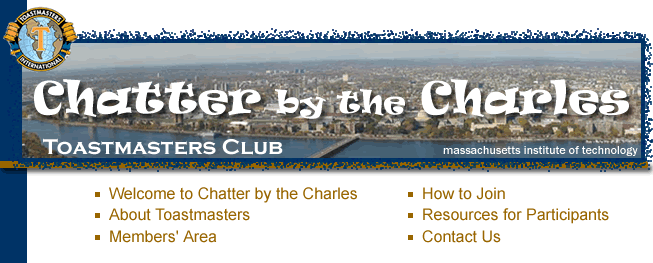![]()
| Meeting Roles | Officer Roles | Mentoring |
Meeting Role Descriptions
- Toastmaster
- Timer
- Grammarian
- Ah Counter
- Speaker
- Table Topics Master
- General Evaluator
- Speech Evaluator
Purpose:
The purpose of table topics is to have members "think on their feet" and
speak for one to two minutes. It is also meant to give people who do not
have a speaking role an opportunity to speak.
Preparation:
Prepare a brief but thorough summary of your role as Table Topics Master
that explains your role in the program to visiting guests. You may want
to include comments about the skills that are improved during the exercises.
Select a theme and at least 6 table topics questions that promote easy
discourse. (There may not be time for all of them.) Feel free to be as
original as you'd like, but make sure to phrase your questions so that
the speaker will know clearly what they are to talk about. Keep in mind
that the goal of Table Topics is to provide an opportunity for members
and guests to speak extemporaneously. This is not a "stump the speaker"
exercise. The Toastmaster will be contacting you the week before the meeting
to confirm your participation and answer any questions you may have.
Before the Meeting:
Take a look at the meeting agenda to see which members do not have roles,
or have only minor roles, in the meeting. These are the people you will
want to call on first. If guests arrive early, briefly explain table topics
and ask whether they would be willing to participate if time allows.
During the Meeting: Explain the purpose and rules of table topics (this should take no more
than two minutes):
Ask your first question, then randomly call on a person to answer. This
lets everyone mentally prepare to answer the question. First call on members
with no other speaking roles, then members with minor roles, then willing
guests, and finally others on the agenda who would like to participate.
Be sure to give guests easy questions.
Stay at the lectern until the person arrives, shake hands, and then
be seated nearby. When the person concludes, be ready to approach the
lectern to shake hands and release the person to sit down.
On completion of the session, thank all participants and return control
of the meeting back to the Toastmaster of the Day.
When the Toastmaster calls on you, approach the lectern and shake the
Toastmasters hand. You are now in control of the meeting.
Introduce your theme or reason for the questions. Try to keep the program
light and positive. Be brief, allowing others to talk.
Helpful Links:
Table
Topics Questions from John Sleigh
Ideas for
Table Topics compiled by Anthony Shipley
Serving
Table Topics by Lois Cook Peterson (PDF)
